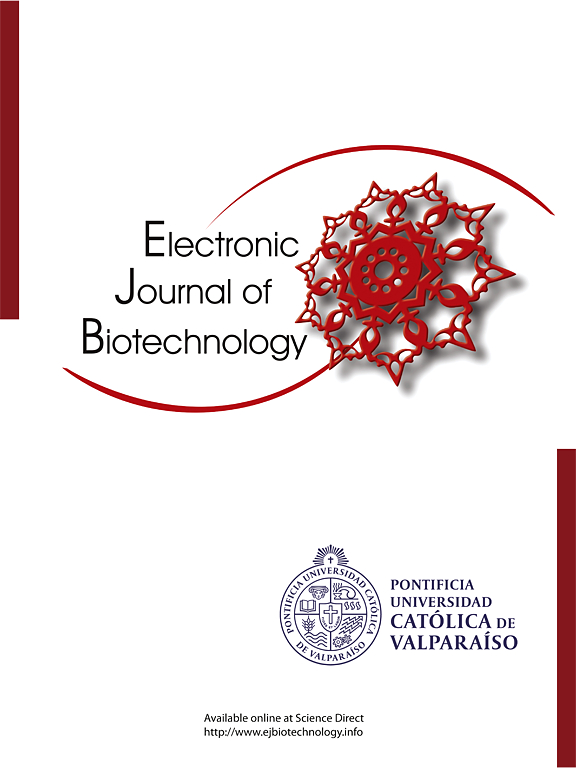绿色合成银纳米粒子的紫堇和紫堇:对多重耐药微生物的抗菌、抗氧化和溶血性能的评价
IF 2.5
4区 生物学
Q3 BIOTECHNOLOGY & APPLIED MICROBIOLOGY
引用次数: 0
摘要
背景抗菌素耐药性的迅速增加对全球健康构成重大威胁,需要采取替代战略来对抗耐多药(MDR)病原体。纳米生物技术的进步可能为这一紧迫问题提供有希望的解决方案。本研究以传统多年生草本植物Viola odorata叶片(VoL)和Onosma hispidum根皮(OhRb)为原料,建立了一种高效合成银纳米颗粒(AgNPs)的方法,并对其抗多药耐药病原菌的抗氧化和抗菌能力进行了评价。结果在55 ~ 60℃条件下,采用绿色途径,15 ~ 20 min完成纳米颗粒的合成。所得AgNPs对大肠埃希菌、铜绿假单胞菌、肺炎克雷伯菌、金黄色葡萄球菌、无乳链球菌和白色念珠菌均有显著的抑菌活性,抑菌范围为12 mm±0.636 ~ 25 mm±0.282。最小抑菌浓度和最小杀菌浓度范围为0.39 ~ 6.125µg/mL。此外,与水提取物相比,纳米颗粒显示出显著的抗氧化潜力。重要的是,对纳米颗粒对红细胞影响的研究显示,即使在更高浓度(300 μ g/mL)的VoL-AgNPs和OhRb-AgNPs下,也没有明显的溶血现象,证明了它们的生物相容性和溶血安全性。结论VoL-AgNPs和OhRb-AgNPs表现出明显的抗菌和抗氧化活性,且溶血最小,强调了它们在对抗耐多药病原体方面的潜力,并进一步适用于治疗环境。然而,有必要进行体内研究以探索其生物医学应用,例如伤口敷料和自由基损伤引起的疾病的治疗。如何引用:Andleeb A, Khalid A, Khalil S等。绿色合成银纳米粒子的紫堇和紫堇:对多重耐药微生物的抗菌、抗氧化和溶血性能的评价。中国生物医学工程学报(英文版);2009;34。https://doi.org/10.1016/j.ejbt.2024.12.003。本文章由计算机程序翻译,如有差异,请以英文原文为准。

Green synthesis of silver nanoparticles using Viola odorata and Onosma hispidum: Evaluation of their antimicrobial, antioxidant, and hemolytic properties against multidrug-resistant microbes
Background
Rapid increase in antimicrobial resistance poses a significant threat to global health, necessitating alternative strategies to combat multi-drug resistant (MDR) pathogens. Advances in nanobiotechnology may offer promising solutions to this pressing issue. This study revolves around developing an efficient method for synthesizing silver nanoparticles (AgNPs) based on aqueous extracts of Viola odorata leaves (VoL) and Onosma hispidum root barks (OhRb), traditional medicinal perennial herbs, followed by evaluating their antioxidant and antimicrobial potential against MDR pathogens.
Results
The synthesis of nanoparticles was completed in 15–20 min at 55–60°C using green approach. The characterized AgNPs showed significant antimicrobial activity against Escherichia coli, Pseudomonas aeruginosa, Klebsiella pneumoniae, Staphylococcus aureus, Streptococcus agalactiae, and Candida albicans, with zones of inhibition ranging from 12 mm ± 0.636 to 25 mm ± 0.282. Minimum inhibitory concentration and minimum bactericidal concentrations ranged from 0.39 to 6.125 µg/mL. Additionally, the nanoparticles demonstrated significant antioxidant potential compared to the aqueous plant extracts. Importantly, the investigation into the effects of the nanoparticles on red blood cells revealed no pronounced hemolysis even at higher concentrations (300 µg/mL) of VoL-AgNPs and OhRb-AgNPs, demonstrating their biocompatibility and hemolytic safety profile.
Conclusions
The VoL-AgNPs and OhRb-AgNPs exhibit appreciable antimicrobial and antioxidant activities with minimal hemolysis, underscoring their potential to combat MDR pathogens, and further applicability in therapeutic settings. However, in vivo studies are warranted to explore their biomedical applications, such as in wound dressings and treatments for disorders caused by free radical damage.
How to cite: Andleeb A, Khalid A, Khalil S, et al. Green synthesis of silver nanoparticles using Viola odorata and Onosma hispidum: Evaluation of their antimicrobial, antioxidant, and hemolytic properties against multidrug resistant microbes. Electron J Biotechnol 2025;74. https://doi.org/10.1016/j.ejbt.2024.12.003.
求助全文
通过发布文献求助,成功后即可免费获取论文全文。
去求助
来源期刊

Electronic Journal of Biotechnology
工程技术-生物工程与应用微生物
CiteScore
5.60
自引率
0.00%
发文量
50
审稿时长
2 months
期刊介绍:
Electronic Journal of Biotechnology is an international scientific electronic journal, which publishes papers from all areas related to Biotechnology. It covers from molecular biology and the chemistry of biological processes to aquatic and earth environmental aspects, computational applications, policy and ethical issues directly related to Biotechnology.
The journal provides an effective way to publish research and review articles and short communications, video material, animation sequences and 3D are also accepted to support and enhance articles. The articles will be examined by a scientific committee and anonymous evaluators and published every two months in HTML and PDF formats (January 15th , March 15th, May 15th, July 15th, September 15th, November 15th).
The following areas are covered in the Journal:
• Animal Biotechnology
• Biofilms
• Bioinformatics
• Biomedicine
• Biopolicies of International Cooperation
• Biosafety
• Biotechnology Industry
• Biotechnology of Human Disorders
• Chemical Engineering
• Environmental Biotechnology
• Food Biotechnology
• Marine Biotechnology
• Microbial Biotechnology
• Molecular Biology and Genetics
•Nanobiotechnology
• Omics
• Plant Biotechnology
• Process Biotechnology
• Process Chemistry and Technology
• Tissue Engineering
 求助内容:
求助内容: 应助结果提醒方式:
应助结果提醒方式:


